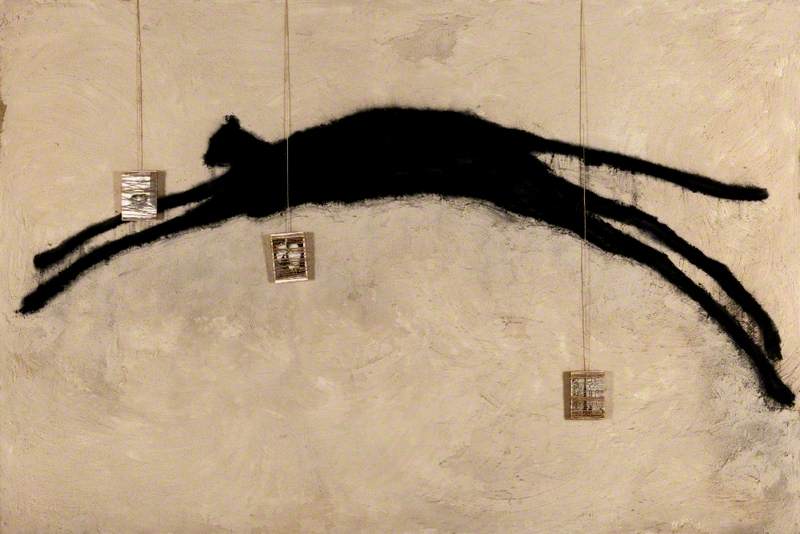Timespan (1987) is a large mixed media painting on canvas in a landscape format. Inspired by a 'botch job' on a wall in Nîmes, France, the artist Tam Joseph noticed that he saw a leaping cat in the way that the wall had been fixed. He used this remembered image for the work and also the material nature of the wall, which he recreated in children's play sand (play sand is unlike building sand as it has no silicates which he knew would discolour) mixed with PVA and then painted. He applied this to the canvas using a builder's trowel. The black cat was was painted with acrylic mixed with PVA and initially the effect of the paint was too glossy. While the canvas was on the floor Joseph sifted black powder paint over the wet painted area of the cat. When this dried he lifted the canvas up and and the loose powder paint created the matt effect he was looking for. One black and white photograph and two postcards were then added with different lengths of string in front of the canvas. Timespan (1987) is an arresting painting that with a closer inspection reveals more about Joseph's political intentions within the work. The black cat is stretched over the three images presenting a positive and powerful leap forward. The image nearer the tail is of Rameses the Great, the Egyptian Pharaoh, the centre image is of Malcolm X, the American Muslim minister and human rights activist and the image over the cat's front paws is of Joseph's daughter, then aged 4. Joseph is interested in how experiences and representation of Black people are defined and do not necessarily change over time. How activists like Malcolm X achieved so much, but then are perceived too powerful and murdered. Timespan is a positive work about a hopeful leap forward in terms of racial equality and human rights, especially for his daughter. But equally Joseph is acknowledging through the inclusion of the three photographic images that time hasn't necessarily changed everything for the better and some struggles are still the same. The photograph and the postcards are also bound by string, which partially obscures, erases the image and potentially sees them struggle to be free. The length of the string relates to the length of Joseph's body and in the proportions and placing of the lengths of string he references the 'Golden Ratio' and the drawings of Leonardo da Vinci. He is therefore placing himself in this work questioning a chronological reading of time and political change. (GoMA)


